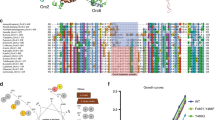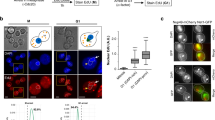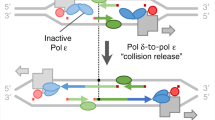Abstract
DNA replication initiates at defined sites called origins, which serve as binding sites for initiator proteins that recruit the replicative machinery. Origins differ in number and structure across the three domains of life1 and their properties determine the dynamics of chromosome replication. Bacteria and some archaea replicate from single origins, whereas most archaea and all eukaryotes replicate using multiple origins. Initiation mechanisms that rely on homologous recombination operate in some viruses. Here we show that such mechanisms also operate in archaea. We use deep sequencing to study replication in Haloferax volcanii and identify four chromosomal origins of differing activity. Deletion of individual origins results in perturbed replication dynamics and reduced growth. However, a strain lacking all origins has no apparent defects and grows significantly faster than wild type. Origin-less cells initiate replication at dispersed sites rather than at discrete origins and have an absolute requirement for the recombinase RadA, unlike strains lacking individual origins. Our results demonstrate that homologous recombination alone can efficiently initiate the replication of an entire cellular genome. This raises the question of what purpose replication origins serve and why they have evolved.
This is a preview of subscription content, access via your institution
Access options
Subscribe to this journal
Receive 51 print issues and online access
$199.00 per year
only $3.90 per issue
Buy this article
- Purchase on Springer Link
- Instant access to full article PDF
Prices may be subject to local taxes which are calculated during checkout




Similar content being viewed by others
References
Robinson, N. P. & Bell, S. D. Origins of DNA replication in the three domains of life. FEBS J. 272, 3757–3766 (2005)
Hartman, A. L. et al. The complete genome sequence of Haloferax volcanii DS2, a model archaeon. PLoS ONE 5, e9605 (2010)
Leigh, J. A., Albers, S. V., Atomi, H. & Allers, T. Model organisms for genetics in the domain Archaea: methanogens, halophiles, Thermococcales and Sulfolobales. FEMS Microbiol. Rev. 35, 577–608 (2011)
Norais, C. et al. Genetic and physical mapping of DNA replication origins in Haloferax volcanii. PLoS Genet. 3, e77 (2007)
Müller, C. A. & Nieduszynski, C. A. Conservation of replication timing reveals global and local regulation of replication origin activity. Genome Res. 22, 1953–1962 (2012)
Sernova, N. V. & Gelfand, M. S. Identification of replication origins in prokaryotic genomes. Brief. Bioinform. 9, 376–391 (2008)
de Moura, A. P., Retkute, R., Hawkins, M. & Nieduszynski, C. A. Mathematical modelling of whole chromosome replication. Nucleic Acids Res. 38, 5623–5633 (2010)
Duggin, I. G., Dubarry, N. & Bell, S. D. Replication termination and chromosome dimer resolution in the archaeon Sulfolobus solfataricus. EMBO J. 30, 145–153 (2011)
Retkute, R., Nieduszynski, C. A. & de Moura, A. Dynamics of DNA replication in yeast. Phys. Rev. Lett. 107, 068103 (2011)
Duggin, I. G., McCallum, S. A. & Bell, S. D. Chromosome replication dynamics in the archaeon Sulfolobus acidocaldarius. Proc. Natl Acad. Sci. USA 105, 16737–16742 (2008)
Skovgaard, O., Bak, M., Lobner-Olesen, A. & Tommerup, N. Genome-wide detection of chromosomal rearrangements, indels, and mutations in circular chromosomes by short read sequencing. Genome Res. 21, 1388–1393 (2011)
Lindås, A. C. & Bernander, R. The cell cycle of archaea. Nature Rev. Microbiol. 11, 627–638 (2013)
Dershowitz, A. et al. Linear derivatives of Saccharomyces cerevisiae chromosome III can be maintained in the absence of autonomously replicating sequence elements. Mol. Cell. Biol. 27, 4652–4663 (2007)
Vujcic, M., Miller, C. A. & Kowalski, D. Activation of silent replication origins at autonomously replicating sequence elements near the HML locus in budding yeast. Mol. Cell. Biol. 19, 6098–6109 (1999)
Vashee, S. et al. Sequence-independent DNA binding and replication initiation by the human origin recognition complex. Genes Dev. 17, 1894–1908 (2003)
Kogoma, T. Stable DNA replication: interplay between DNA replication, homologous recombination, and transcription. Microbiol. Mol. Biol. Rev. 61, 212–238 (1997)
Kreuzer, K. N. & Brister, J. R. Initiation of bacteriophage T4 DNA replication and replication fork dynamics: a review in the Virology Journal series on bacteriophage T4 and its relatives. Virol. J. 7, 358 (2010)
McGlynn, P., Savery, N. J. & Dillingham, M. S. The conflict between DNA replication and transcription. Mol. Microbiol. 85, 12–20 (2012)
McCready, S. et al. UV irradiation induces homologous recombination genes in the model archaeon, Halobacterium sp. NRC-1. Saline Syst. 1, 3 (2005)
Woods, W. G. & Dyall-Smith, M. L. Construction and analysis of a recombination-deficient (radA) mutant of Haloferax volcanii. Mol. Microbiol. 23, 791–797 (1997)
Delmas, S., Shunburne, L., Ngo, H. P. & Allers, T. Mre11-Rad50 promotes rapid repair of DNA damage in the polyploid archaeon Haloferax volcanii by restraining homologous recombination. PLoS Genet. 5, e1000552 (2009)
Large, A. et al. Characterization of a tightly controlled promoter of the halophilic archaeon Haloferax volcanii and its use in the analysis of the essential cct1 gene. Mol. Microbiol. 66, 1092–1106 (2007)
Ogawa, T., Pickett, G. G., Kogoma, T. & Kornberg, A. RNase H confers specificity in the dnaA-dependent initiation of replication at the unique origin of the Escherichia coli chromosome in vivo and in vitro. Proc. Natl Acad. Sci. USA 81, 1040–1044 (1984)
Matsunaga, F. et al. Genomewide and biochemical analyses of DNA-binding activity of Cdc6/Orc1 and Mcm proteins in Pyrococcus sp. Nucleic Acids Res. 35, 3214–3222 (2007)
Newman, T. J., Mamun, M. A., Nieduszynski, C. A. & Blow, J. J. Replisome stall events have shaped the distribution of replication origins in the genomes of yeasts. Nucleic Acids Res. http://dx.doi.org/10.1093/nar/gkt728. (19 August 2013)
Breuert, S., Allers, T., Spohn, G. & Soppa, J. Regulated polyploidy in halophilic archaea. PLoS ONE 1, e92 (2006)
Storchova, Z. et al. Genome-wide genetic analysis of polyploidy in yeast. Nature 443, 541–547 (2006)
Rosenshine, I., Tchelet, R. & Mevarech, M. The mechanism of DNA transfer in the mating system of an archaebacterium. Science 245, 1387–1389 (1989)
McGeoch, A. T. & Bell, S. D. Extra-chromosomal elements and the evolution of cellular DNA replication machineries. Nature Rev. Mol. Cell Biol. 9, 569–574 (2008)
Allers, T., Ngo, H. P., Mevarech, M. & Lloyd, R. G. Development of additional selectable markers for the halophilic archaeon Haloferax volcanii based on the leuB and trpA genes. Appl. Environ. Microbiol. 70, 943–953 (2004)
Bryson, V. & Szybalski, W. Microbial selection. Science 116, 45–51 (1952)
Delmas, S., Duggin, I. G. & Allers, T. DNA damage induces nucleoid compaction via the Mre11-Rad50 complex in the archaeon Haloferax volcanii. Mol. Microbiol. 87, 168–179 (2013)
Allers, T., Barak, S., Liddell, S., Wardell, K. & Mevarech, M. Improved strains and plasmid vectors for conditional overexpression of His-tagged proteins in Haloferax volcanii. Appl. Environ. Microbiol. 76, 1759–1769 (2010)
Alkan, C. et al. Personalized copy number and segmental duplication maps using next-generation sequencing. Nature Genet. 41, 1061–1067 (2009)
Pelve, E. A., Martens-Habbena, W., Stahl, D. A. & Bernander, R. Mapping of active replication origins in vivo in thaum- and euryarchaeal replicons. Mol. Microbiol.. http://dx.doi.org/10.1111/mmi.12382 (16 September 2013)
Mullakhanbhai, M. F. & Larsen, H. Halobacterium volcanii spec. nov., a Dead Sea halobacterium with a moderate salt requirement. Arch. Microbiol. 104, 207–214 (1975)
Wendoloski, D., Ferrer, C. & Dyall-Smith, M. L. A new simvastatin (mevinolin)-resistance marker from Haloarcula hispanica and a new Haloferax volcanii strain cured of plasmid pHV2. Microbiology 147, 959–964 (2001)
Lestini, R., Duan, Z. & Allers, T. The archaeal Xpf/Mus81/FANCM homolog Hef and the Holliday junction resolvase Hjc define alternative pathways that are essential for cell viability in Haloferax volcanii. DNA Repair 9, 994–1002 (2010)
Acknowledgements
This work was supported through the Biotechnology and Biological Sciences Research Council (BBSRC) (BB/E023754/1, BB/G001596/1). We thank the BBSRC for a David Phillips Fellowship awarded to C.A.N. and the Royal Society for a University Research Fellowship awarded to T.A., R. Wilson for preparing libraries for sequencing, A. de Moura and I. Duggin for sharing unpublished data, and numerous colleagues for discussions.
Author information
Authors and Affiliations
Contributions
M.H., C.A.N. and T.A. conceived and designed experiments; M.H. and T.A. performed experiments; S.M. prepared libraries for sequencing; M.J.B. aligned sequencing data to the genome; C.A.N. analysed sequencing data; M.H., C.A.N. and T.A. interpreted results and wrote the paper.
Corresponding authors
Ethics declarations
Competing interests
The authors declare no competing financial interests.
Extended data figures and tables
Extended Data Figure 1 Correcting for GC-bias in deep sequencing data.
Sequence composition has previously been reported to influence the depth of sequence coverage34. Therefore we investigated whether GC-content contributes to the noise in our data. Sequence reads from the wild isolate (DS2) stationary-phase sample were analysed with respect to GC-content. a, For each 1 kb window of unique sequence the number of mapped reads was plotted against the GC-content of the window. We found a significant reduction in mapped sequence reads at elevated GC-content. A polynomial equation (inset and solid line) was fitted to the data. b, For each 1 kb window of unique sequence, the read counts were plotted against chromosome position. c, Using the method of Alkan et al.34, we corrected for GC-bias using the polynomial equation shown in a and then plotted the corrected sequence reads against GC-content. d, GC-bias-corrected sequence reads are shown plotted against chromosomal position. With no substantial continuing replication in the stationary-phase sample, we can justify using this data set to normalize the exponential phase data. Both normalization methods result in low noise compared with studies that do not use a normalization step35.
Extended Data Figure 2 Replication profiles and copy numbers of mega-plasmids.
Relative copy number plotted against chromosomal coordinate (kb) for pHV1 and pHV3 of (a) wild isolate DS2, (b) laboratory strain H26, (c) ΔoriC1 H1269, (d) ΔoriC2 H1267, (e) ΔoriC3 H1371, (f) ΔoriC1,2,3 H1374 and (g) ΔoriC1,2,3,pHV4 H1546. Each mega-plasmid is shown linearized at position 0, the location of previously described origins4. The 6 kb pHV2 plasmid is not shown in the wild isolate owing to the scarcity of data points; pHV2 is not present in laboratory strains (b–g). The pHV4 data for DS2 are shown in Fig. 1. Separate pHV4 data for laboratory strains (b–g) are excluded, because pHV4 is incorporated into the main chromosome in these strains (Figs 1 and 3). h, Relative copy number for each mega-plasmid was calculated using the GC-content normalized sequence counts from the stationary-phase data for laboratory strain H26.
Extended Data Figure 3 Characterization of oriC3.
a, Sequence features of oriC3. Double-headed arrow indicates the autonomously replicating fragment recovered from a genomic library of H1023 (pTA1100; see Methods for details); solid arrows, open reading frames; triangles, repeats. The intergenic region upstream of orc2 is typical of archaeal origins. It is enlarged to show the sequence features of oriC3 duplex unwinding element (DUE). HVO_0635 encodes a conserved hypothetical protein. b, Sequence of intergenic repeats upstream of orc2 (numbered in a, triangles show repeat orientation). Dark grey shading indicates match to consensus origin recognition box (ORB); bases conserved between repeats are indicated by light grey shading. c, Plasmid-based assays for the three chromosomal origins. Recombination-deficient strain H112 was transformed with 1 µg of pTA441 (oriC1), pTA612 (oriC2) or pTA1100 (oriC3). Transformants were plated with 100-fold dilution on Hv-Ca and incubated at 45 °C for 14 days. Numbers indicate transformation efficiency in colony-forming units (c.f.u.) per microgram of DNA. d, GC-disparity of main chromosome in wild isolate DS2 (adapted from ref. 4); positions of orc genes and replication origins are shown. The lack of a nucleotide disparity inflection point at oriC3 suggests that this origin has been acquired recently or is used infrequently, consistent with the replication profile (Fig. 1a) and plasmid-based assay (Extended Data Fig. 3c).
Extended Data Figure 4 Identifying integration of pHV4 into the main chromosome.
a, Map of region around ISH18 insertion sequence element HVO_0278 on the main chromosome of wild isolate DS2, showing restriction sites and probes used to determine the integration of pHV4. b, Map illustrating integration of pHV4 into the main chromosome of laboratory strain H26, by recombination between ISH18 HVO_0278 (chromosome) and ISH18 HVO_A0279 (pHV4). Regions upstream and downstream of the integration are depicted with the same restriction sites and probes shown in Extended Data Fig. 4a, in addition to the genomic fragments cloned in pTA1238 and pTA1236. c, Restriction fragment length polymorphisms in the main chromosome of laboratory strain H26. Genomic DNA from wild isolate DS2 and laboratory strain H26 was digested with KpnI, ClaI or NarI, and probed with sequences upstream (US) and downstream (DS) of ISH18 insertion sequence element HVO_0278. The upstream 3,646 bp NarI fragment of H26 was cloned in pTA1238, and the downstream 7,478 bp KpnI fragment of H26 was cloned in pTA1236. See Methods for details.
Extended Data Figure 5 Identifying chromosomal rearrangement in ΔoriC1,2,3 ΔradA strain H1553.
a, Map of SfaAI restriction sites on the main chromosome of wild isolate DS2. The region around ISH18 HVO_0278 is shown with additional restriction sites and the probe. b, Map of SfaAI restriction sites on the main chromosome of laboratory strain H26. The region downstream of integrated pHV4 is shown with the same restriction sites as in Extended Data Fig. 5a, and two extra probes (ori-pHV4 and bgaH) that hybridize to pHV4. c, Map of SfaAI restriction sites on the main chromosome of ΔoriC1,2,3 ΔradA strain H1553. The region downstream of integrated pHV4 is shown as in Extended Data Fig. 5b. H1553 has undergone a chromosomal rearrangement involving part of pHV4 between ISH18 HVO_A0014 and ISH18 HVO_0278. These ISH18 elements are identical in sequence but in an inverted orientation (bold arrows); recombination between them results in inversion of the intervening sequence. d, Restriction fragment length polymorphisms in H26 and H1553. Genomic DNA from wild isolate DS2, laboratory strain H26, ΔoriC1,2,3 strain H1501 and ΔoriC1,2,3 ΔradA strain H1553 was digested with SfaAI and shown on a pulsed-field gel. Southern blots were probed with the ori-pHV4 origin, bgaH gene (located on pHV4 (ref. 21)) and sequences downstream (DS) of ISH18 element HVO_0278. e, Confirmation of restriction fragment length polymorphisms by ClaI, KpnI and NarI digests, probed with sequences downstream (DS) of ISH18 element HVO_0278; see also Extended Data Fig. 4.
Extended Data Figure 6 Generating tryptophan-inducible radA strains.
a, Map of p.tnaA-radA+ gene replacement plasmid pTA1343. b, Map of region around radA, showing NspI restriction sites and the probe used to determine replacement of the native radA gene with the tryptophan-inducible radA allele. c, Confirmation of radA replacement by p.tnaA-radA+::hdrB+. Genomic DNA from laboratory strain H26, ΔoriC1,2,3,pHV4 strain H1546, p.tnaA-radA+ strain H1637 and ΔoriC1,2,3,pHV4 p.tnaA-radA+ strain H1642 was digested with NspI and probed with the radA region. See Methods for further details.
Supplementary information
Supplementary Table 1
This file shows the deep sequencing data, it contains the following data from each experiment: chromosome or mega-plasmid, mid-point of 1 kb windows used, GC proportion for 1 kb windows, sequence reads for stationary and exponential phase samples, ratio of exponential to stationary phase sequence reads, normalized ratio, genomic co-ordinates for the reconstructed main chromosome. (XLS 5255 kb)
Source data
Rights and permissions
About this article
Cite this article
Hawkins, M., Malla, S., Blythe, M. et al. Accelerated growth in the absence of DNA replication origins. Nature 503, 544–547 (2013). https://doi.org/10.1038/nature12650
Received:
Accepted:
Published:
Issue Date:
DOI: https://doi.org/10.1038/nature12650
This article is cited by
-
Chromosome architecture in an archaeal species naturally lacking structural maintenance of chromosomes proteins
Nature Microbiology (2023)
-
Escherichia coli cell factories with altered chromosomal replication scenarios exhibit accelerated growth and rapid biomass production
Microbial Cell Factories (2022)
-
Genomic analysis finds no evidence of canonical eukaryotic DNA processing complexes in a free-living protist
Nature Communications (2021)
-
DNA copy-number measurement of genome replication dynamics by high-throughput sequencing: the sort-seq, sync-seq and MFA-seq family
Nature Protocols (2020)
-
Archaeal cells share common size control with bacteria despite noisier growth and division
Nature Microbiology (2017)
Comments
By submitting a comment you agree to abide by our Terms and Community Guidelines. If you find something abusive or that does not comply with our terms or guidelines please flag it as inappropriate.



